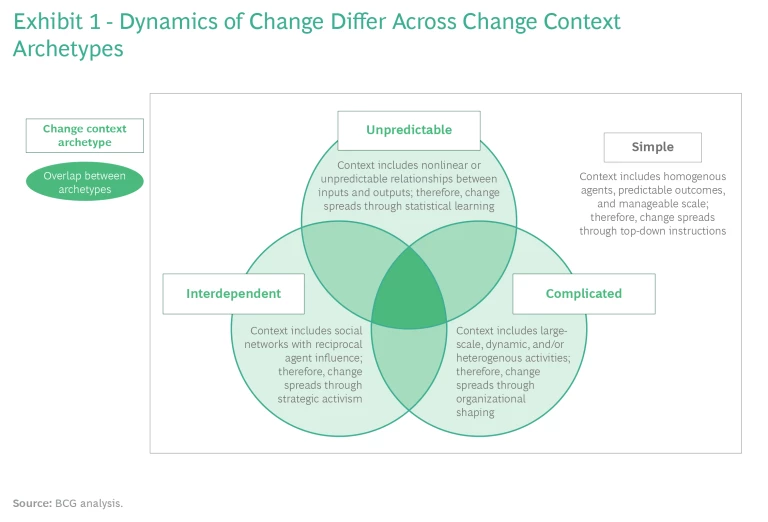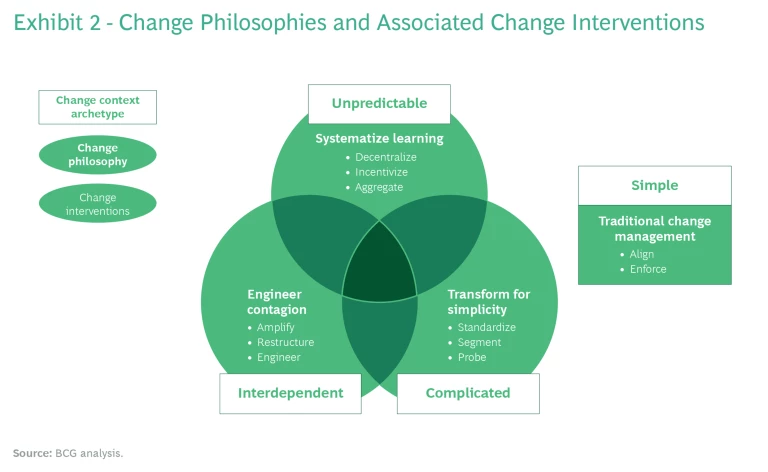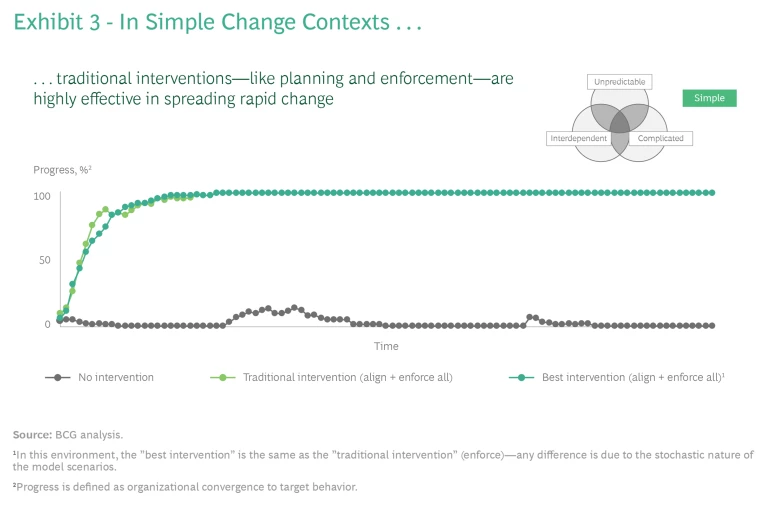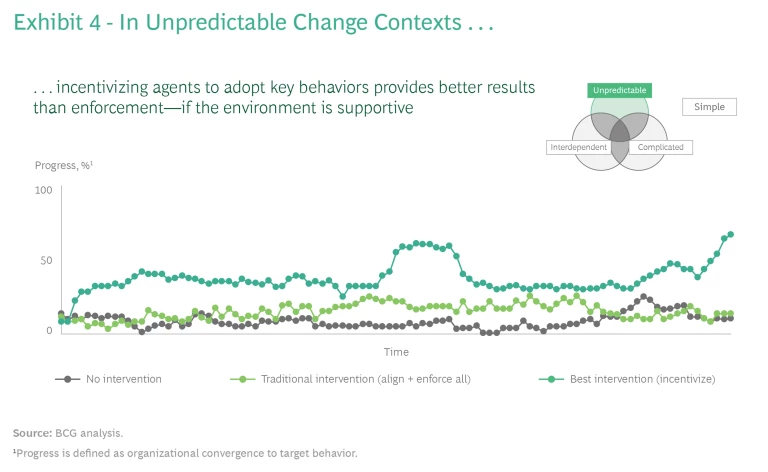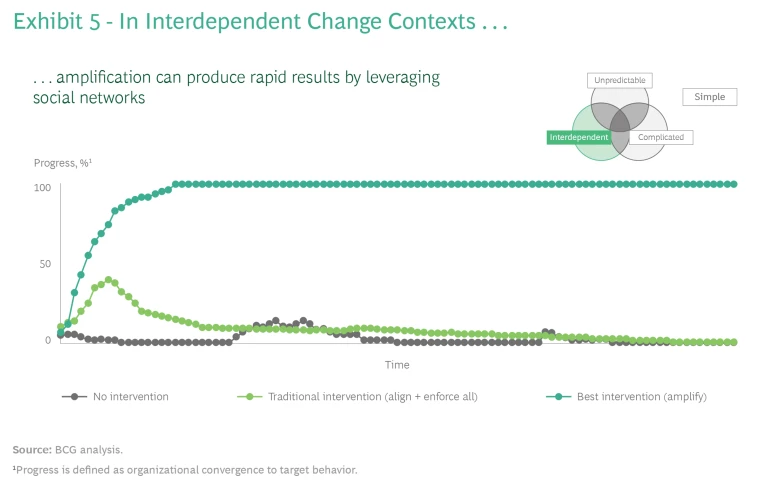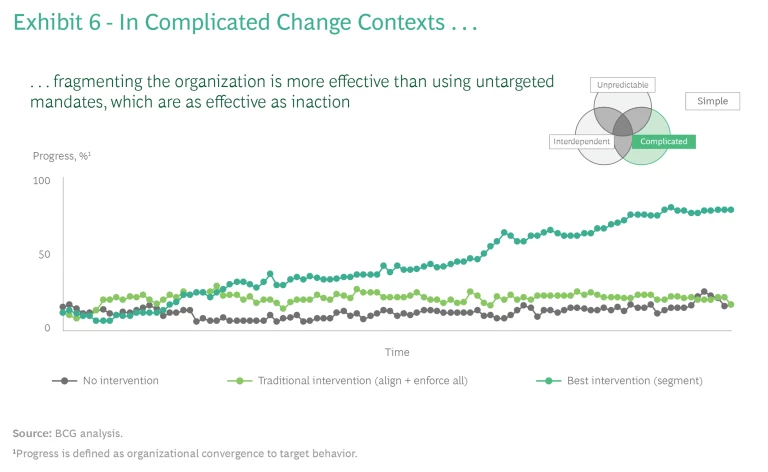Instead of defaulting to the standard change management methods, leaders should adopt strategies of change that respond appropriately to the specific characteristics of their change context.
A large, multinational organization is about to undertake an ambitious transformation effort. To do this, it hires a seasoned chief transformation officer, who promptly sets up a project management office and begins to roll out detailed plans, carefully defined milestones, and a battery of Gantt charts.
While this is a common scene across corporate transformation programs, our research shows that only about 25% of such efforts succeed in both the short and long terms. Given this unimpressive track record, why do we keep relying on the same traditional change management tactics time after time?
Changing Change Management
Part of the problem is that the presumed supremacy of classical change management techniques blinds leaders to the variety of organizational contexts in which change occurs. Leaders therefore tend to rely on those standard approaches, rather than adapting their change strategy to their specific situation. Effective change management requires leaders to shift away from one-size-fits-all approaches and develop an expanded set of context-specific strategies.
An effective change strategy begins with an understanding of the specific mechanisms of change, as determined by the change context. We define a change context as the pattern of endogenous factors that shape how change spreads. Though change contexts can vary widely across organizations, leaders can benefit from recognizing a few salient archetypes from which more nuanced strategies can be constructed.
This article focuses on four key context archetypes. Simple change contexts are those in which agents are homogenous, predictable, and manageable. Unpredictable change contexts are those in which the relationships between inputs and outputs are unclear, so the effects of specific interventions are hard to predict. Interdependent contexts are those characterized by networks of reciprocal interactions in which social influence from peers has a stronger effect on agents’ behaviors than top-down influence. Finally, complicated contexts are those that are dynamic, large in scale, and/or composed of heterogenous agents. These archetypes do not exhaust the variety of possible change contexts. However, they highlight some ways in which change efforts need to depart from traditional change management techniques to be effective in specific contexts.
Each of these archetypes is associated with a characteristic family of interventions that can spread change within a given context. While traditional change management techniques work well in simple change contexts, they are less effective in unpredictable, interdependent, and complicated environments. To illustrate this idea, we have designed a change simulator that generates organizational networks to embody these different change contexts and models how they respond to various interventions.
As traditional sources of competitive advantage decline in persistence, increasing the speed at which leading companies are overtaken by competitors that operate on different business models, effective change management will become increasingly critical to success—and even survival. Therefore, instead of defaulting to the standard change management methods, leaders should adopt appropriate strategies of change that respond to the specific characteristics of the change context and adjust as the organization evolves.
Our proposed framework—which pairs context archetypes with appropriate interventions under holistic change philosophies—together with the change simulator, can help managers navigate a wider range of options to transform the organizations they lead.
Understanding Change Contexts
Depending on the intended change effort, a change context may encompass the entire organization or only a part, such as a single team. In either case, leaders need to understand how that context works—what drives agents’ current behaviors and what would be needed to change them. Leaders can do this by assessing individual change contexts against one of the four change context archetypes. (See Exhibit 1.)
Simple contexts are those in which agents and activities are directly manageable. Such contexts are characterized by relatively homogenous agents, interventions that have predictable outcomes, manageable scale, and agents that are responsive to top-down influence. These are contexts in which traditional change management works well and should be deployed. But leaders will often encounter contexts that depart from this simple archetype.
Unpredictable contexts are those in which leaders cannot predict the outcomes of interventions. For example, imagine that Company A wants to increase its rate of product innovation. However, it cannot simply mandate that employees submit new or better ideas because leaders would not be able to predict which employees would respond to the directive or how the types and styles of employee submissions might differ. Employee responses depend primarily on the employees’ interests and capabilities and are, therefore, difficult to anticipate.
Because outcomes in this context are unpredictable and their odds are unknown—and thus difficult to manage directly—change can most effectively be shaped by systematizing learning across the organization. To do this, leaders can create statistical learning systems that encourage experimentation, aggregate learnings, and iteratively adapt approaches to bring about the desired change.
Interdependent contexts are those in which peer influence is stronger than top-down directives. This is true when agents are connected through robust and reciprocal social networks, resulting in horizontal influence that is stronger than the effect of top-down mandates.
Suppose Company B is having trouble getting employees to buy into its new ethical AI policies, which encourage people to report any potential harms or risks associated with their projects—such as applying AI software to determine hiring criteria. Rather than following company-wide guidelines, individuals may tend to report concerns only if other people to whom they are socially connected do so as well. This behavior makes sense if people are more personally invested in the perceptions of members of their social groups—especially those with whom they interact frequently—than in the interests of company leadership.
In an interdependent context, change spreads primarily through reciprocal agent influence. Leaders can therefore spread change through “strategic activism”—the use of peer influence, interpersonal interventions, and incentives to amplify beneficial behaviors.
In complicated contexts, activities or agents are large in scale, heterogenous, and/or dynamic. These factors make direct management difficult even when outcomes are predictable and leadership retains a strong influence.
Imagine that Company C, a large, multinational organization, is just returning to the office following the COVID-19 pandemic. To avoid outbreaks across its various offices and regions, leaders want to increase employee vaccination rates. However, accomplishing this goal involves navigating the ever-changing nature of the pandemic, understanding numerous regional and local COVID regulations and vaccine availabilities, and addressing diverse—and potentially contradictory—employee opinions related to vaccine compliance. A one-size-fits-all, top-down solution will likely not work.
When facing a complicated change context, leaders can seek to transform it into a simpler one by, for instance, implementing mandates that standardize behavior or dividing the organization into smaller units. Furthermore, by using exploratory probes, tests, and pilots, leaders can learn how to reduce the influence of complicating factors.
In reality, of course, change contexts are rarely pure archetypes. Therefore, leaders must understand the extent to which their context is unpredictable, interdependent, or complicated. In fact, a change context may be all of these things at once—as in many large-scale transformations—and the context itself may evolve over time. Understanding this will better enable leaders to identify the most effective interventions for their specific situation.
Choosing Appropriate Interventions
Once a change context is properly understood in terms of its unpredictability, interdependence, or complicatedness, leaders will be better able to identify the most effective interventions to advance their change efforts.
The appropriateness of individual interventions varies across contexts and over time within the same organization. For this reason, rather than picking from a long list of potential interventions, we encourage leaders to think in terms of coherent “change philosophies.” A change philosophy is a holistic approach that helps organizations deploy a set of interventions that are well suited to the change context.
The following change philosophies correspond to the change context archetypes described in the previous section:
Traditional change management. Interventions that rely on top-down influence are the most effective ones for simple contexts because change can be managed directly through unilateral and uniform leadership mandates. Interventions that support traditional change management are those that align the organization by developing plans and assigning decomposable task sets to agents and enforce these activities through tracking and directly managing implementation. These approaches generally assume that the change problem is both knowable and relatively static.
These interventions embody the change philosophy of “traditional change management,” which enables leaders to directly manage activities across the organization through top-down instructions. Most leaders are already familiar with this philosophy, and it is relevant in many common change scenarios. But the success rate of traditional change management confirms that it isn’t well suited to every change context.
Systematizing learning. Interventions that allow for iterative adaptation are the most effective ones for unpredictable contexts where the relationship between inputs and outputs is not deterministic. Interventions that enable statistical learning are those that decentralize learning opportunities by creating a distributed ability to gather data and test solutions (for example, by redistributing funds to support pilot programs); incentivize experimentation by actively encouraging controlled exploration and testing of new solutions (for example, by creating innovation competitions); and aggregate learnings by creating feedback loops to compile, assess, select, and disseminate findings about effective solutions across the organization (for example, using analytical software to assess change progress).
These interventions embody the change philosophy of “systematizing learning,” which enables leaders to discover patterns in an organization’s behavior and thus refine its change effort over time.
For Company A to be successful in increasing product innovation (as discussed in the previous section), it needs to create learning systems across the organization. The leaders of Company A can use such interventions to increase employees’ interest in and ability to create new products.
This is precisely the approach taken by Recruit Holdings. Recruit holds two annual events for employees to present new business ideas. Teams are given funding to explore their ideas, and the winning teams see their ideas implemented and are recognized throughout the company. Employees are strongly incentivized to participate in the events and have quickly learned how to effectively pitch innovative proposals. As a result, Recruit has generated almost $800 million in revenue thanks to ideas that have come from employees’ initiatives.
Engineering contagion. Interventions that intentionally shape peer influence are the most effective ones for interdependent contexts because reciprocal agent influence is the primary driver of change. For example, in the case of fisheries management, norms around harvesting behavior can be reinforced through social mechanisms—such as ostracism—in order to promote cooperative behavior. To spread change in an interdependent context, managers can amplify beneficial behaviors by publicly highlighting agents that demonstrate desired traits (for example, by appointing champions); restructure connections by reshaping the organization’s social network to link distinct individuals and groups (for example, by developing integrated product teams); and engineer interactions by bringing agents together around mutually beneficial goals or ideas (for example, by creating innovation clubs).
These interventions embody a change philosophy we call “engineering contagion,” which enables leaders to leverage the organization’s own networks of reciprocal influence. In this context, however, leaders must avoid the temptation to overly simplify or engineer information to accelerate change. This can lead to social polarization, which in turn can make change more difficult.
Let’s take another look at Company B, which is attempting to encourage employees to comply with its ethical AI policies and practices. To do so, the company’s leaders need to engineer contagion and use strategic activism to encourage employees to report concerns. Microsoft offers a clear example of this philosophy in action. To spread the company’s Responsible AI strategy, Microsoft’s leadership has appointed and trained Responsible AI Champions to sit on teams across the company. These champions are responsible for raising awareness of the Responsible AI principles, and they have built an organizational culture centered on AI ethics.
Transforming for simplicity. Interventions that segment and simplify the organization are the most effective ones in complicated contexts. These interventions enable leaders to eliminate some of the factors driving complicatedness, such as scale and heterogeneity. More generally, complicated environments should be addressed through the notion of bounded rationality, which encourages people to “satisfice” rather than “optimize,” thereby creating solutions that are “good enough” given the information they have even if they are not perfectly effective. In contrast to optimizing, satisficing allows for progress while still leaving room for further improvement, and it reduces the complicatedness of interventions. In order to simplify complicated change contexts, leaders can standardize behaviors to constrain the effects of agent heterogeneity (for example, by standardizing RACI charts); segment the organization by creating smaller, simpler organizational units that are easier to manage (for example, by subdividing large teams); or probe the system to better understand how the organization responds to different stimuli, even if the reasons and limits of this are not understood in detail (for example, by piloting change activities with small groups).
These interventions embody a change philosophy we call “transforming for simplicity,” which enables leaders to reduce the impact of heterogeneity and scale and allow for adaptation to changing conditions.
Recall Company C’s attempts to increase vaccination rates among employees. The company spans multiple countries and has a large employee base, so scale poses a challenge to implementation. Furthermore, there are regional and individual differences in vaccine sentiment. No single, one-size-fits-all approach will work.
Walmart found itself in such a situation in 2021, as it sought to ensure employee and customer safety in its facilities. Early in the pandemic, Walmart instituted uniform social distancing and mask mandates in its facilities for all employees, eliminating the heterogeneity caused by diverse personal beliefs. Later, as vaccines were released, the company adapted its policies to the changing conditions, mandating mask wearing and social distancing only for unvaccinated employees. However, as the Delta variant spread throughout the US, Walmart tried a new tactic and segmented the organization into groups based on local conditions, requiring all employees in areas of high transmission—but not in other regions—to wear masks in its facilities regardless of vaccination status.
These change philosophies should be deployed within the context for which they are best suited. (See Exhibit 2.) When leaders encounter change contexts that combine traits of unpredictability, interdependence, or complicatedness, they should deploy the appropriate combination of interventions.
We built a change simulator to illustrate how the effectiveness of change interventions varies according to the change context. To do this, the model creates organizational networks with differing degrees of interdependence, unpredictability, and complicatedness and tests the effectiveness and dynamics of various interventions.
The Change Simulator
The change simulator is an agent-based model designed to explore the spread of change across an organization. The simulator randomly generates organizations that correspond to the four change context archetypes: simplicity, unpredictability, interdependence, and complicatedness. Each organization comprises a network of heterogenous agents whose individual profiles determine how likely they are to change their behavior, both in general and in response to specific pressures. For example, agents in an organization characterized by interdependence tend to conform their behavior to that of their peers rather than that of leadership.
The simulator models change by defining a target behavior for each agent and applying interventions that exert behavioral pressure through leaders, peers, or information. Because the organization is a complex, partially connected network of heterogenous agents that possesses inertia, change is not instantaneous. Instead, each intervention results in a modified organizational profile, with agents adjusting to the intervention to various degrees. The modified network then responds to subsequent interventions differently than the original network would have. Through this process, the simulator shows the dynamics of change over time, including the limits and reversals resulting from specific interventions.
Simplicity. First, we illustrate the simple archetype of relatively homogenous and disconnected agents and predictable dynamics. In this context, leaders can declare a new target behavior and generally expect most employees to eventually comply without further intervention. Therefore, the most effective interventions are to align leadership instructions with the target behaviors and to enforce them. (See Exhibit 3.)
We used this combination of interventions (align and enforce) across the remaining change context simulations as a proxy for traditional change management methods in order to illustrate how alternative interventions can be more effective in unpredictable, interdependent, and complicated contexts.
Unpredictability. In the next simulation, we tested the performance of different interventions in unpredictable change contexts. In this case, agents who change their behavior in response to leadership instructions will adopt a stochastic response, so top-down change management efforts will be largely ineffective. To uncover response patterns, leaders must encourage systematized learning across the organization. (See Exhibit 4.)
Leaders can incentivize agents to actively explore the environment for traits that match the target behavior; these incentives will then increase the pressure on agents to adopt the new behavioral traits, supporting bottom-up learning. However, due to the strong influence of the environment in unpredictable contexts, incentives will only be effective in producing desired behaviors while the environment reinforces those behaviors. Leaders must do what they can to provide productive learning conditions and reduce negative influence. Agents’ responses to incentives—or lack thereof—will teach leaders about the characteristic desires or interests of their organizations, which can inform future strategies.
Interdependence. We next modeled the interdependent change context archetype, in which agents are connected through social networks and are disproportionately responsive to peer influence. These networks present leaders with an opportunity to leverage existing positive behaviors across the organization to create feedback loops that make others more likely to pick up such behaviors. (See Exhibit 5.)
The best intervention in this scenario is to identify agents who have already adopted the target behavior and then amplify their influence, increasing the pressure on other agents to match their behavior. As the number of individuals who adopt target behaviors increases, so will the social pressure on others to converge on those behaviors, increasing its likelihood of spreading even further. Leaders must carefully choose which behavior to amplify, because networks of reciprocal influence can transmit and reinforce counterproductive as well as positive actions.
Complicatedness. Finally, we simulated complicated change contexts. These contexts are modeled as organizations in which each agent has a different target behavior, meaning that leaders cannot simply use a one-size-fits-all approach. Instead, leaders should segment the organization into smaller units that can then be given a set of standardized behaviors. To do this, leaders need to target smaller groups of agents—or even individuals—to enforce the correct behavior. (See Exhibit 6.)
This can be a lengthy process; leaders must go through many additional steps to individually engage the relevant groups. However, because it enables the exploration of independent yet parallel strategies, segmented enforcement is far more effective than untargeted mandates.
The change simulator illustrates that the effectiveness of change interventions depends largely on the change context. No single change philosophy—not even traditional change management—works equally well in every case.
Furthermore, the simulator shows that, although change may be easier to affect in some contexts than in others, agents can be influenced through carefully considered action in virtually every context. For example, agents in an unpredictable context may not respond well to direct intervention but can still be influenced through incentivized experimentation. This translates to real-world scenarios in which leaders should prioritize experimentation and decentralized learning over directives and mandates for change efforts in unpredictable contexts.
Building Your Change Toolkit
Even with a better understanding of the various change contexts, leaders may still instinctively lean toward traditional change management methods. To avoid this, and to extract maximum benefit from a context-dependent approach, leaders can build a new integrated transformation effort from the following strategies.
Expand opportunities for change. The current reliance on stepwise, top-down planning may stem in part from the limited or overly simplified nature of the change efforts leaders are willing to undertake. Rather than pursuing change only in limited or comfortable circumstances, leaders should broaden their horizons and consider more challenging opportunities for change. Change opportunities may often become apparent through formal planning, but they can also be sparked by serendipitous observation or experimentation. When leaders expand their view of what change is possible, they are better able to conceive of and implement a greater variety of change interventions.
Deaverage large change problems. Often, leaders do not take the time to understand the different parts of the change effort. To tackle a large change problem, leaders must deconstruct the broader transformation effort into its component parts. These parts can include different change goals or different groups within the organization, each with unique traits that may call for different interventions. By understanding the differences between components, leaders can avoid the indiscriminate and uniform application of change interventions that do not work well across all components.
Probe to better understand the change context. Once leaders have a sense of the different components of their transformation effort, they can implement quick, probing actions (such as deploying pilot initiatives among limited segments of the organization) to test their context. These probes can provide insight into and confirmation of the change context.
Match the change philosophy to the change context. With an understanding of the various features of their change context, leaders can then identify the associated roadblocks they are likely to face—and the interventions that will drive their success. These interventions should be articulated as part of a change philosophy that fits the change context in question. For example, if a leader recognizes that the change context is both large in scale and heterogenous, they will know to implement the “transforming for simplicity” change philosophy instead of relying on traditional change management interventions.
Master a wide range of tactical interventions. As leaders select and deploy an appropriate change philosophy, they are able to identify specific interventions that suit their current situation. However, change contexts themselves change over time—especially as transformation efforts succeed in reshaping an organization. Therefore, leaders need to remain flexible and be ready to adapt their change philosophies. As an example, instead of relying on a single tactic, Continental Airlines successfully implemented multiple strategies based on the needs of the organization. It changed the company culture by replacing previous officers with new individuals, developing a new incentive for employees to improve on-time performance, implementing a plan to improve customer service through city assignments for leaders, improving communication among employees, and centering the new culture on employee engagement and company pride. To ensure an expanded understanding of potential solutions, leaders should conduct broad, cross-industry research to identify relevant precedents and creative interventions, rather than relying on planning or personal experience.
Leverage workplace analytics to observe progress in real time and adapt. By using data instead of instinct or sluggish, subjective reporting, leaders can better understand the change context and fine tune interventions accordingly. Once leaders select a set of interventions, clear and effective tracking processes can help monitor the impact of their chosen tactics. These can include project management software, network mapping software, and regular pulse-check surveys, all of which provide input on change progress and stakeholder buy-in and satisfaction. AI and analytics can be used to better mine complex patterns in the output from these assessments, providing detailed insights on the status of the change effort and helping leaders tune interventions going forward. Organizations such as Pymetrics provide workplace analytics that leaders can use to assess and design change interventions.
Not all change efforts are created equal. Success requires that the change toolkit be expanded far beyond the methods of traditional change management. With a new appreciation for the diversity of the change contexts they might face, leaders are better equipped to adopt the right change philosophies to shape the future of their organizations.

